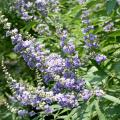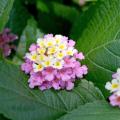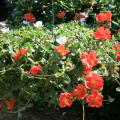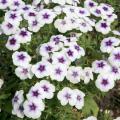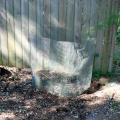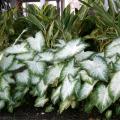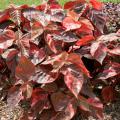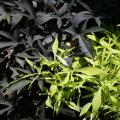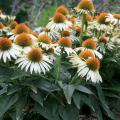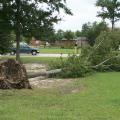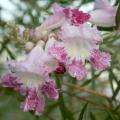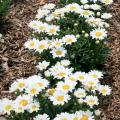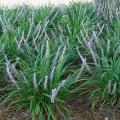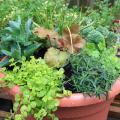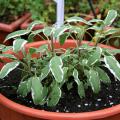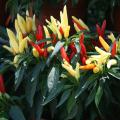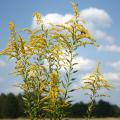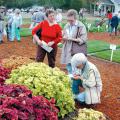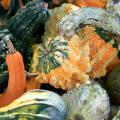Southern Gardening from 2010
The Chastetree has begun flowering, and its brilliant blooms are causing many to stop and take notice.
The native range of Chastetree is the low woodlands of southern Europe and western Asia. It was first introduced to the United States by settlers in the 1500s. Known botanically as Vitex agnus-castus, the name dates back to ancient Greece, when Athenian woman lined their beds with the leaves during the feast of Ceres. It also known as chasteberry and monks pepper.
If you’re looking for a way to keep your flowerbeds pretty after your pansies have worn out, consider using lantanas as your transition. They will provide fantastic color through the hottest temperatures.
Lantana has been selected twice as a Mississippi Medallion winner. The very first medallion plant in 1996 was New Gold lantana, and its bright, golden-yellow flowers are outstanding. The second Medallion win came in 2003 to Sonset lantana, whose flowers start as yellow and transition through orange, red, magenta and purple.
I read once that many flowering plants we use in our landscapes are really only one or two steps out of the ditch. This is especially true of some of the new varieties being introduced to the market.
Purslane is one of the newer plants that I have been interested in that is really an old plant. It is a succulent that thrives in high summer temperatures. Purslane has long been regarded by many as a garden weed, and I have removed many of these from the garden and landscape.
Many gardeners wouldn’t dare plant a bed without having at least one variety of phlox present.
Gardeners enjoy several spring-flowering phlox such as woodland phlox and creeping phlox. But I am referring to garden phlox, Phlox paniculata, which is a special plant to have in the garden.
The flower display of garden phlox is spectacular, and the showy panicles can have up to 50 individual flowers each. Colors range from soft pastels to surprisingly brilliant hues in pink, purple, lavender, red and white. Bi-colors have an eye in the center.
Compost is nature's gift to our gardens, helping retain moisture and aerate the soil, and it is easy to make and totally free. Compost is one of the greatest bargains for both experienced and novice gardeners.
Compost is the dark, crumbly, partially decomposed form of organic waste material on its way to becoming humus. Compost is an excellent soil conditioner. It is easy to handle and stores for long periods.
Angelonia and caladium should top your shopping list when you visit your favorite garden center looking for summer color.
For full sun, select Angelonia, also called summer snapdragons. These plants begin flowering in late spring and continue to bloom profusely until frost. They require very little deadheading.
Because plants with round flowers dominate the garden world, the spiky texture of the Angelonia flower stalks offers welcome contrast in any summer garden.
Gardeners who want color in the landscape usually concentrate their efforts on flowering annuals and perennials, often overlooking plants with colorful foliage like caladiums, striped cannas or gingers.
But plants with colorful foliage can be used instead of flowering bedding plants or even in the shrub border. They have always been popular with some gardeners, but there seems to be a growing interest in these colorful foliage plants.
What relative of the morning glory makes an ornamental ground cover featuring beautiful, colorful foliage?
If your answer is ornamental sweet potatoes, then you are right. Ornamental sweet potatoes, known botanically as Ipomoea batatas, are actual sweet potatoes selected for their vivid and attractive leaves. The plants produce a flower that resembles a morning glory but is hidden by the foliage. They also produce edible tubers.
Deadheading is an important garden maintenance activity, but many gardeners overlook the importance of removing spent flowers.
We deadhead flowering plants to extend the bloom period, to remove the seed source of species that could become weedy and to maintain the health of flowering garden plants.
As we enter the most active part of hurricane season, now is a good time to think about ways to help landscape trees recover from storm damage.
A common myth is that the root system mirrors the top growth of a tree. While some trees do put down deep roots, most of a tree’s root system is in the top 12 to 14 inches of soil. Roots need to be near the surface to exchange carbon dioxide and oxygen gases and to ensure healthy root and tree growth. These roots also help stabilize the tree. You can see their presence and arrangement in trees that have been blown over.
I spent last week in Palm Desert, Calif., where the daily temperatures were 110 degrees or more and the humidity was less than 20 percent.
The landscapes I saw there are completely foreign to our lush, green gardens. Yet the landscape was quite beautiful, not bleak as I had imagined. There were lots of flowering desert plants, and I quickly realized that one of the first things I needed to get was a desert plant guide.
When we hear the word “daisy,” most of us think of the flower with white petals and a yellow center that we used as children to play the “loves me, loves me not” game.
Growing the Shasta daisy in your garden can bring back some of those old memories. Known botanically as Leucanthemum x superbum, Shasta daisy is a classic garden plant that is as at home in the modern landscape as it is in the cottage garden. It really shines in the garden.
Liriope is an old standard when the Mississippi landscape calls for a groundcover. It is reliable in both full sun or shade, and as long as the soil is well drained, liriope will thrive in heat and drought.
Liriope is commonly known as monkeygrass or lilyturf. It is a versatile groundcover, effective under large trees where sunlight is limited or mass planted on slopes. It also creates soft borders for paved areas and foundations.
We all know annuals such as petunia or million bells are great container garden plants, but have you ever tried including perennials in container gardens? This important group of plants can and should be an ingredient in every container recipe.
Many gardeners have a strict mindset about using annuals and perennials in container gardens: annuals are annuals and perennials are perennials, and never the twain shall meet. But if you base all your buying decisions on whether a plant will come back the next year, you will miss out on some beautiful flowers and foliage.
It may be early September, but now is a good time to start thinking about growing fresh herbs to harvest during the winter months.
Fresh herbs are relatively easy to grow in containers. In addition to offering a feast for the palate, herbs can offer a feast for the eyes. Many of the basic herb species are available in variegated or multicolored foliage. The multicolored ones work well in recipes, but they also make flavorful garnishes.
After reading about ornamental vegetables several years ago, I became interested in expanding the selection of ornamental bedding plants in my landscape. Then I saw a planting of ornamental peppers.
I am a true “chili head” with a passion for hot peppers, and I have even made an apple and habanero wine. I have grown jalapeño, habanero and the like as bedding plants, as many of the extremely hot peppers produce very colorful fruit.
A garden itself is a form of personal expression, so what better way to say something about yourself than with garden art?
When we think of a garden, we often think of flowering annuals and perennials, foundation shrubs like hollies and Indian hawthorns, and small ornamental trees. But add a sculpture or homemade piece of art, and you start to bridge the gap between the gardener and the garden.
I firmly believe that many of our flowering landscape plants are only a step or two away from being weeds growing in a ditch. But goldenrod is an exception. Can you believe some gardeners are intentionally growing goldenrod?
Most folks recognize goldenrod growing wild when they see the explosion of golden color late in the summer, just before the temperatures start to decrease in the fall.
The Fall Flower and Garden Festival at Mississippi State University’s Truck Crops Experiment Station in Crystal Springs is one of the best horticulture field days in the Southeast. Come Oct.15 and 16 for free fun for the entire family. There will be a lot to see for everyone from garden novices to Master Gardeners.
The 3-acre garden site will showcase a great selection of tough roses, ornamental grasses like the native Gulf Coast muhly grass, tropical plants, and fall vegetables and herbs.
The changing season and cooler temperatures make now the perfect time to decorate the front porch with a fall harvest display. These displays are ideal for Halloween and add charm through the season.
Remember to use more than just pumpkins in your display. Pumpkins are a member of the cucurbit family, which also includes squashes and gourds. Pumpkins can be orange, red, yellow, white, blue, or striped. They can be miniature, flattened, necked, smooth, winged or warty.

